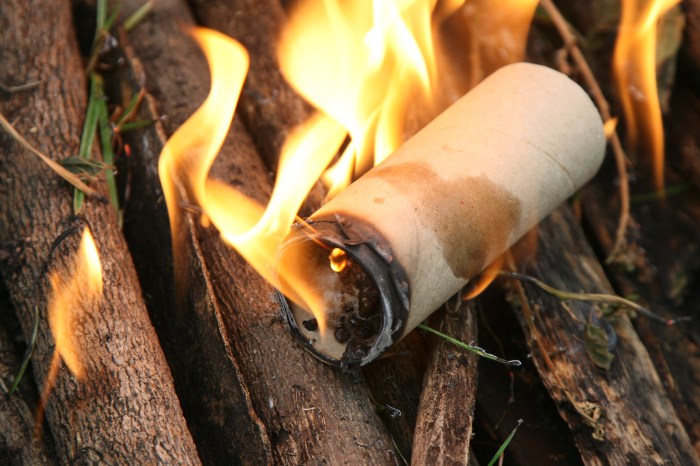DIY firestarters are a fantastic way to ensure you can always start a fire, whether you’re on a camping trip, preparing for an emergency, or simply enjoying a cozy night by the fireplace. These homemade fire starters are surprisingly easy to make, using readily available materials and simple techniques. You can customize your firestarters to suit your needs, creating compact and portable options for backpacking or larger, long-lasting fire starters for your backyard bonfire.
Table of Contents
From using everyday household items like cotton balls and dryer lint to incorporating natural materials like pine cones and fatwood, there’s a DIY firestarter recipe for everyone. This guide explores the basics of firestarter construction, covers advanced techniques, and provides valuable tips for safety, storage, and troubleshooting. You’ll learn how to create reliable fire starters that ignite easily, burn efficiently, and can be tailored to any situation.
Introduction to DIY Firestarters
DIY firestarters are a great way to ensure you can always start a fire, no matter the weather conditions. They are also a cost-effective and environmentally friendly alternative to commercially available fire starters.
There are several benefits to making your own fire starters. You can customize them to suit your specific needs, and you can often make them using readily available materials. This can save you money and reduce your environmental impact.
Types of Materials
DIY firestarters can be made using a variety of materials. Some of the most common materials include:
- Wax: Paraffin wax, beeswax, and soy wax are all popular choices. Wax helps to bind the other ingredients and provides a long-burning fuel source.
- Sawdust: Sawdust from hardwoods is a good choice for firestarters. It burns quickly and easily, and it helps to absorb the wax.
- Cotton Balls: Cotton balls are a good source of tinder and can be easily soaked in wax.
- Cardboard: Cardboard can be shredded or cut into small pieces and used as a fuel source.
- Dryer Lint: Dryer lint is a good source of tinder and can be used in fire starters.
Choosing the Right Materials
When choosing materials for your DIY fire starters, consider the following factors:
- The type of wood you will be burning: If you are burning softwoods, you will need a fire starter that burns hotter. Hardwoods burn more slowly, so you can use a fire starter that burns more slowly.
- The weather conditions: If you are starting a fire in wet or windy conditions, you will need a fire starter that is waterproof and windproof.
- Your personal preferences: Some people prefer fire starters that are easy to light, while others prefer fire starters that burn for a long time.
Firestarter Safety and Storage: Diy Firestarters

DIY firestarters, while convenient and fun to make, require careful handling and storage to prevent accidents and ensure safe use. Understanding the potential hazards and implementing safe practices is crucial for both you and your surroundings.
Safety Hazards
It is important to be aware of the potential safety hazards associated with DIY firestarters. While they are designed to start fires, they can also pose risks if not handled properly.
- Flammable Materials: DIY firestarters often contain highly flammable materials like wax, cotton balls, and fuel. These materials can easily ignite and cause fires if not handled with care.
- Open Flame: The act of using a firestarter involves an open flame, which can be a fire hazard if not controlled properly. It is crucial to use firestarters only in designated areas and with appropriate safety measures in place.
- Improper Storage: Storing firestarters in a haphazard manner can lead to accidental ignition. Improper storage can also cause the firestarters to become damaged or contaminated, making them less effective or more dangerous.
Safe Storage and Handling
Safe storage and handling are crucial for preventing accidents and ensuring the longevity of your firestarters.
- Store in a Cool, Dry Place: Keep firestarters in a cool, dry place away from direct sunlight, heat, and moisture. Extreme temperatures can affect the flammability and effectiveness of the firestarter.
- Use a Fireproof Container: Store firestarters in a fireproof container, such as a metal tin or a ceramic jar. This will prevent accidental ignition and protect the firestarters from damage.
- Keep Out of Reach of Children: Firestarters should be stored in a location inaccessible to children. This will prevent them from playing with or accidentally igniting the firestarters.
- Handle with Care: Always handle firestarters with care, avoiding contact with flammable materials or open flames. It is also important to keep firestarters away from your face and body to prevent burns.
Responsible Use
Using firestarters responsibly is essential for ensuring safety and preventing unintended consequences.
- Use in Designated Areas: Always use firestarters in designated areas, such as a fireplace, campfire ring, or grill. Never use firestarters in enclosed spaces or areas where they could ignite flammable materials.
- Avoid Overuse: Firestarters are designed to help ignite a fire, not to sustain it. Use only the amount of firestarter necessary to start the fire, and then add additional fuel as needed.
- Extinguish Properly: Always extinguish firestarters completely before disposing of them. Ensure that the fire is completely out and that there are no remaining embers.
Firestarter Troubleshooting and Tips

Even the most experienced firestarter can encounter problems from time to time. It’s essential to understand the common issues and how to troubleshoot them for a reliable and efficient fire-starting experience.
Troubleshooting Common Firestarter Issues, Diy firestarters
Troubleshooting common firestarter issues involves identifying the cause of the problem and taking appropriate steps to rectify it. Here are some common issues and their solutions:
Uneven Burning
Uneven burning can occur due to inconsistent fuel distribution or poor compaction.
- Ensure that the fuel is evenly distributed throughout the firestarter. Use a consistent ratio of fuel to binder, and avoid creating large air pockets.
- Compact the firestarter tightly to ensure a consistent burn. Use a press or a heavy object to compact the mixture firmly.
- Consider using a different fuel source. Some fuels burn more evenly than others. For instance, using a combination of wood shavings and dryer lint can result in a more consistent burn compared to solely using dryer lint.
Difficulty Igniting
Difficulty igniting can be caused by several factors, including insufficient fuel, moisture, or improper ignition technique.
- Use a high-quality ignition source, such as a lighter or waterproof matches. Ensure the flame is large and stable enough to ignite the firestarter.
- Make sure the firestarter is dry. Moisture can hinder ignition. Store firestarters in a dry place or use a waterproof container.
- Apply the flame directly to the center of the firestarter. This will help the fire spread more quickly and evenly.
- Consider using a firestarter with a higher ignition temperature. Some firestarters are formulated to ignite more easily, even in damp conditions.
Short Burn Time
A short burn time can be due to insufficient fuel, improper compaction, or using a firestarter that is too small.
- Increase the amount of fuel in the firestarter. Using a larger amount of fuel will result in a longer burn time.
- Compact the firestarter tightly. This will help to increase the density of the fuel and extend the burn time.
- Use a larger firestarter. A larger firestarter will naturally have a longer burn time.
Tips for Enhancing Firestarter Performance
Here are some practical tips and tricks to improve the performance of your firestarters:
Using a Firestarter
- Place the firestarter in the center of your tinder bundle. This will help to ensure that the flame spreads evenly throughout the tinder.
- Use a small amount of kindling to build a small fire around the firestarter. This will help to protect the firestarter from wind and allow it to burn more efficiently.
- Once the firestarter has ignited the tinder, gradually add larger pieces of kindling to build a larger fire.
Storing Firestarters
- Store firestarters in a dry, airtight container. This will help to protect them from moisture and extend their shelf life.
- Consider using a desiccant pack in the container to absorb any moisture that may be present.
- Avoid storing firestarters in direct sunlight or heat. This can cause the fuel to degrade and reduce the firestarter’s effectiveness.
Firestarter History and Cultural Significance

The history of firestarters is intertwined with the evolution of humankind. From the earliest days of our species, fire has played a vital role in our survival and development. The ability to control fire marked a significant turning point in human history, allowing us to cook food, stay warm, ward off predators, and create light in the darkness. Firestarters, the tools used to ignite flames, have evolved alongside our understanding and control of fire.
The Early History of Firestarters
Early humans relied on natural methods to start fires, using friction, percussion, or the heat generated by sunlight. These methods were often time-consuming and unreliable. The development of firestarters marked a significant step forward in fire-making technology.
- Hand Drills: One of the earliest methods involved spinning a wooden stick rapidly against a piece of wood, creating friction that generated heat and eventually ignited tinder.
- Bow Drills: The bow drill improved upon the hand drill by using a bow to rotate the stick faster, generating more heat. This method allowed for faster and more reliable fire starting.
- Fire Plough: The fire plough involved rubbing a wooden stick against a groove in a piece of wood, creating friction that generated heat and eventually ignited tinder.
- Flint and Steel: This method, which emerged around 5000 BC, involved striking a piece of flint against a piece of steel, producing sparks that ignited tinder. Flint and steel became a common firestarting method for centuries.
Cultural Significance of Firestarters
Firestarters have held significant cultural and spiritual meaning in various societies throughout history.
- Ceremonial Use: In many cultures, firestarting was seen as a sacred act. Firestarters were often used in rituals and ceremonies, symbolizing the power of fire and its ability to transform and purify.
- Social Importance: Firestarting was often a social activity, bringing people together for warmth, cooking, and storytelling. The skill of firestarting was passed down through generations, fostering a sense of community and shared knowledge.
- Symbolism: Firestarters have been used as symbols in art, literature, and mythology, representing concepts such as creation, transformation, and the cycle of life and death.
With a little creativity and some basic supplies, you can create your own reliable and effective firestarters. Whether you’re a seasoned outdoorsman or just starting out, DIY firestarters offer a sense of self-reliance and a fun, practical project for any skill level. So, gather your materials, follow the instructions, and get ready to enjoy the warmth and convenience of homemade fire starters. You’ll be surprised at how easy and rewarding it is to create your own fire-starting solutions.
DIY firestarters are a great way to ensure you’re always prepared for a campfire or emergency. You can use a variety of materials, like cotton balls soaked in wax, to create reliable ignition sources. However, if you’re looking for something a bit more specialized, you might consider using benzonatate 100 mg , which is a medication for cough suppression.
While not typically used for firestarting, it’s a good example of how even seemingly unrelated items can be repurposed for unexpected uses. Just remember to always prioritize safety and handle any flammable materials with care.

